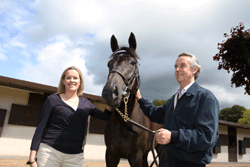- All modern variants traced back to the legendary Nearctic
- Wide increase in variants of original ‘speed gene’ traced to Northern Dancer
Scientists have traced the origin of the ‘speed gene’ in Thoroughbred racehorses back to a single British mare that lived in the United Kingdom around 300 years ago, according to findings published today in the scientific journal Nature Communications.
The origin of the ‘speed gene’ (C type myostatin gene variant) was revealed by analysing DNA from hundreds of horses, including DNA extracted from the skeletal remains of 12 celebrated Thoroughbred stallions born between 1764 and 1930.
“Changes in racing since the foundation of the Thoroughbred have shaped the distribution of ‘speed gene’ types over time and in different racing regions,” explained Dr Emmeline Hill, the senior author of the study, and a genomics scientist at the School of Agriculture and Food Science, University College Dublin.
“But we have been able to identify that the original ‘speed gene’ variant entered the Thoroughbred from a single founder, which was most likely a British mare about 300 years ago, when local British horse types were the preeminent racing horses, prior to the formal foundation of the Thoroughbred racehorse.”
The international scientific team led by scientists from University College Dublin (UCD), Equinome Ltd and the University of Cambridge, have traced all modern variants of the original ‘speed gene’ to the legendary Nearctic (1954–1973), and attribute the wider expansion of these variants to Northern Dancer (1961–1990), the son of Nearctic, and one of the most influential stallions of modern times.

Parish Hall (far right) wins the Group 1 Dubai Dewhurst Stakes at Newmarket in October 2011 for owner/breeder/trainer Jim Bolger. Northern Dancer is prominent on both the sire and dam side of his pedigree. Trevor Jones, Thoroughbred Photography Ltd
“Having first identified the ‘speed gene’ in 2010, we decided to see if we could trace the origin of the gene variant using population genetics coupled with pedigree analysis. We wanted to understand where speed in the Thoroughbred came from.”, said Dr Hill.
Dr Hill is also a co-founder of Equinome, a UCD spin-out company headquartered at NovaUCD, which has developed The Equinome Speed Gene Test. This test is currently being used by the global bloodstock and racing industry to identify the optimum racing distance for individual Thoroughbred horses.

Dr Emmeline Hill with Jim Bolger, the renowned the renowned Irish racehorse trainer and breeder, pictured with Banimpire. Dr Hill and Mr Bolger are the co-founders of Equinome.
“We traced the economically valuable gene variant by determining ‘speed gene’ type in almost 600 horses from 22 Eurasian and North American horse breeds, museum bone and tooth specimens from 12 legendary Thoroughbred stallions, 330 elite performing modern Thoroughbreds from 3 continents, 40 donkeys and two zebras.”, added Dr Hill.
According to co-author Dr Mim Bower from the University of Cambridge, UK, “The findings point to a British mare as the most likely single founder of the original ‘speed gene’ because one of the lines of evidence from the research demonstrated that the prize stallions of the 17th and 18th centuries had two copies of the T type speed gene variant (T:T) which is linked to greater stamina.”
“At this time in the history of horse racing, races were between two horses competed over multiple heats, at distances of between two to four miles, and repeated until a horse had won the event twice or ‘distanced’ the opponent. Horses did not race until they were five or six years old, and then only two or three times in their lives. This is consistent with these horses being T:T types.”, said Dr Bower
An increased premium on speed and precocity developed as two-year-old races became popular during the last century, and in many regions of the world, these preferences remain to this day.
Dr Hill explained, “For example, in Australia, the myostatin ‘speed gene’ type (C:C), which is best suited to fast, short-distance, sprint races, is more common and there is a market driven demand for horses with at least one copy of the C type gene variant.”
“This just goes to show the power breeders have to shape the genetic make-up of their horses. Decisions regarding the race pattern in each racing jurisdiction and the commercial demand for certain types will also rapidly influence the genetic make-up of the population.”
To identify where the C type gene variant originated, the researchers analysed DNA samples from more than 20 horse breeds that included representatives of local British and Irish horses, from where female Thoroughbred lineages derive, and exotic eastern populations from where male Thoroughbred lineages derive.
The study identified the Shetland breed as having the highest frequency of the C type gene variant. The Shetland represents local British horse types, which were the preeminent racing horses prior to the formal foundation of the Thoroughbred.
By comparing the diversity of the chromosomes around the C and T type gene variants researchers found only a single C type compared to 11 different T type gene variants, meaning that the ‘speed gene’ entered the Thoroughbred just once.
“The results show that the ‘speed gene’ entered the Thoroughbred from a single founder, which was most likely a British mare about 300 years ago when local British horse types were the preeminent racing horses, prior to the formal foundation of the Thoroughbred racehorse.”, said Dr Hill.
Collaborators in the study were scientists from Trinity College Dublin, the Russian Academy of Sciences and the Swedish University of Agricultural Sciences. The research wassupported by grants from The Horserace Betting Levy Board, Leverhulme Trust, Cambridge Overseas Trust and Science Foundation Ireland.
“I am very grateful for the support of our research. Ireland has been renowned as a leader in the production of world class racehorses for generations, and continues to lead now in the application of new scientific technologies in breeding and racing. We are seeing a shift globally to scientifically informed decision-making.”, said Dr Hill.
ENDS
24 January 2012
The full scientific paper: “The genetic origin and history of speed in the Thoroughbred racehorse.” published in Nature Communications is available at: http://www.nature.com/ncomms/index.html
Subscribers can access the paper directly at: http://dx.doi.org/10.1038/ncomms1644
For further information contact: Micéal Whelan, University College Dublin, Communications Manager (Innovation), e: miceal.whelan@ucd.ie, t: +353 1 716 3712, Alexandra Buxton, University of Cambridge, Communications Office, e: amb206@admin.cam.ac.uk, t: +44 1223 761673, Donal Ryan, Managing Director, Equinome, e: donal.ryan@eqinome.com or t: +353 1 716 3776.
Editor’s Notes
Additional information: The myostatin gene is central to the control of muscle mass development in many species. In Thoroughbreds variation at this gene is highly predictive of race distance aptitude and is associated with speed and early skeletal muscle development.
Horses with two copies of the speed type myostatin gene variant (C:C) are best suited to fast, short-distance, sprint races (1000m–1600m); C:T horses compete favourably in middle-distance races (1400m–2400m); and T:T horses have greater stamina (> 2000m).
In the donkeys and zebras studied, only the T type myostatin gene variant was detected indicating that this was the ancestral wild gene type.
Analysis of the skeletal remains of 12 of the most important stallions central to the development of the Thoroughbred breed, including Eclipse (an undefeated 18th century British Thoroughbred) found that all of the historic stallions were T:T.
Dr Emmeline Hill hails from a family synonymous with horse racing and breeding in Ireland. Her grandmother was Charmian Hill, the owner of Dawn Run, the only racehorse to have completed the Cheltenham Champion Hurdle (1984) and Gold Cup (1986) double. She joined UCD in 2002 as a post-doctoral researcher. In 2004 she became a UCD Principal Investigator when she was awarded a Science Foundation Ireland President of Ireland Young Researcher Award. Dr Hill maintains strong industry links with horse breeding and training operations in Ireland and internationally and is a member of the International Horse Genome Mapping Group and the International Horse Genome Sequencing Consortium. She graduated in 1995 with a BA (Genetics) from Trinity College Dublin and a PhD in Molecular Population Genetics in 2000.
Dr Mim Bower is a Researcher in Archaeogenetics at the McDonald Institute for Archaeological Research, University of Cambridge. She specialises in analysing ancient DNA to address key questions of archaeological interest. She is interested in how the relationships between humans and animals – such as horses - have impacted on genetics and shaped the natural world. Her research projects include: the spread of the chariot in the 2nd and 1st millennia; prehistoric horse domestication; and genetic variation in historic elite Thoroughbred horses.
Equinome, a world-leading equine genomics company, was established in 2009 as a result of groundbreaking research at University College Dublin led by company co-founder, Dr Emmeline Hill, in partnership with racehorse trainer Mr Jim Bolger. Headquartered at NovaUCD, the Innovation and Technology Transfer Centre, Equinome’s ongoing research and development activities continue to support collaborations between world-class science and elite racehorse breeding and training, with facilities established at UCD and at Jim Bolger’s training yard in Co. Kilkenny, Ireland. Through this research Equinome is continuing to drive the cutting-edge of equine performance genomics. www.equinome.com
NovaUCD, the Innovation and Technology Transfer Centre, is the hub of innovation and knowledge transfer activities at University College Dublin. NovaUCD is responsible for the commercialisation of intellectual property arising from UCD research and for the development of co-operation with industry and business. NovaUCD as a purpose-built centre also nurtures new technology and knowledge-intensive enterprises such as Equinome. NovaUCD has been funded through a unique public-private partnership that includes AIB Bank, Arthur Cox, Deloitte, Enterprise Ireland, Ericsson, Goodbody Stockbrokers, UCD and Xilinx. www.ucd.ie/nova.